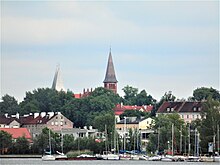Warmian–Masurian Voivodeship
The Order encouraged colonization by German settlers in Warmia (Ostsiedlung) and Polish colonists from the region of Masovia, called Masurians (Mazurzy), hence the name Masuria.The wars eventuated in a rebellion by the urban populations of Pomerelia and Warmia, who were affected by the Teutons' numerous wars; upon the urban populations' request, the region was incorporated into Poland by King Casimir IV Jagiellon, and after the Thirteen Years' War it remained under Polish suzerainty, but was divided into two parts: Elbląg and Warmia were incorporated directly into the Kingdom of Poland, while Masuria became a Polish fief under the control of the Teutonic Order, also considered an integral part of "one and indivisible" Kingdom of Poland.[3] The state of the Teutonic Order ceased to exist in 1525 when Grandmaster Albert Hohenzollern introduced secularisation, proclaimed the Duchy of Prussia, and became a vassal of Sigismund I of Poland.With the German invasion of Poland at the start of World War II in 1939, the Germans eventually carried out mass arrests of local Poles, shut down or seized Polish newspapers and libraries,[4] and occupied the pre-war Polish areas of the present-day province, in which they established the Soldau concentration camp, and carried out massacres of Poles, including at Bratian, Nawra, Malinowo and Komorniki.Stalag I-B, a major German prisoner-of-war camp for Polish, Belgian, French, Italian, Serbian and Soviet POWs,[6] and Wolf's Lair, Adolf Hitler's first Eastern Front military headquarters were located in Masuria.After the end of World War II, the German population was expelled in accordance with the Potsdam Agreement, whereas many Masurians emigrated in the following decades.[10] But the majority of East Prussian Polish and Lithuanian inhabitants were Lutherans, not Roman Catholics like their ethnic kinsmen across the border in the Russian Empire.Only in Southern Warmia Catholic Poles – so called Warmiaks (not to be confused with predominantly Protestant Masurians) – comprised the majority of population, numbering 26,067 people (~81%) in county Allenstein (Polish: Olsztyn) in 1837.[14] The Warmian–Masurian Voivodeship has the largest number of ethnic Ukrainians living in Poland[15] due to forced relocations (such as Operation Vistula) carried out by the Soviet and Polish Communist authorities.The Wolf's Lair, Adolf Hitler's first Eastern Front military headquarters in World War II is located in Gierłoż.









VoivodeshipCoat of armsBrandmarkcountiesOlsztynElblągBartoszyce CountyBraniewo CountyDziałdowo CountyElbląg CountyEłk CountyGiżycko CountyGołdap CountyIława CountyKętrzyn CountyLidzbark CountyMrągowo CountyNidzica CountyNowe Miasto CountyOlecko CountyOlsztyn CountyOstróda CountyPisz CountySzczytno CountyWęgorzewo CountyExecutive boardVoivodeRadosław KrólMarshalMarcin KuchcińskiPodlaskie and Warmian–MasurianTime zoneISO 3166 codeVehicle registrationOlsztyn-Mazury AirportHighwaysgminasNUTS 2provincePolandOlsztyn VoivodeshipSuwałki VoivodeshipElbląg VoivodeshipPolish local government reformsWarmiaMasuriaChełmno LandPowiślePodlaskie VoivodeshipMasovian VoivodeshipKuyavian-Pomeranian VoivodeshipPomeranian VoivodeshipVistula LagoonKaliningrad OblastexclaveOld PrussianBartiansPogesaniansWarmiansTeutonic OrderState of the Teutonic OrderOstsiedlungMasoviaMasuriansBattle of GrunwaldJan MatejkoHanseatic LeaguePomereliaLithuaniaCasimir IV JagiellonThirteen Years' WarKingdom of PolandPolish–Lithuanian CommonwealthAlbert HohenzollernDuchy of PrussiaSigismund I of Polandpersonal unionBrandenburg-PrussiaTreaty of OlivaPartitions of PolandEast PrussiaGerman EmpireSoldau concentration campDziałdowoBattle of TannenbergEastern FrontWorld War IWeimar RepublicNazi Germanyinvasion of PolandWorld War IIBratianMalinowoKomornikiStutthof concentration campStalag I-BGerman prisoner-of-war campFrenchItalianWolf's LairAdolf HitlerPotsdam AgreementmergerWest PrussiaKarl Andreeethnically Polishethnically LithuanianAugust von HaxthausenLutheransRoman CatholicsRussian EmpireCatholic PolesWarmiaksProtestant Masurianscounty AllensteinPhilipponnenWojnowoGermanisationKulturkampfEvangelical ChristiansMennonitesUkrainians living in PolandOperation VistulaPolish CommunistPasłękFloris V, Count of Holland


